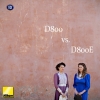Blog
NIKON D800 and D800E – almost twins (01.09.2012)
Photographer Kaupo Kikkas tested the two Nikon sister cameras D800 and D800E. We asked him to explain, which are the main technological possibilities and differences of those similar cameras.
What is your impression after working with them?
It probably does not come as a surprise to anyone that technology has developed but how far has it exactly gone. For me, the current situation is exciting because for the first time it can be seriously stated that in certain situations, a 35mm camera can replace a medium format camera. When during the camera film era, it was exactly known what is the size of the film surface or the frame format of a medium format camera, then during the digital era, there are a number of ”medium format” cameras, which’ sensor surface is a bit bigger than that of the 35mm frame.
On the other hand, if we do not have two or three times bigger surface, on which to project the image, it is reasonable to ask, whether the small advantage of a 20% bigger frame is still an argument today for buying a different camera set? Middle format cameras cost a lot of money and secondly, they are quite cumbersome and thirdly, it is a separate camera set, so the photographer has to own many different sets, which is extremely uncomfortable and expensive. So, the D800 makes many photographers question whether they need separate camera sets.
But from those who have not thought about middle format and have so far managed with the 35mm or a smaller so called APS size sensor, the camera wipes their feet off with the quality it offers. It can be said that nothing alike has ever been seen before in the 35mm world.
The supplement that probably many photographers in the whole world are still waiting is the option of using a smaller Raw fail. Let’s be honest – D800 is so powerful that we do not need its maximum – which is the 210 megabit .tif fail converted through the 16 bits converter – that often. For example, photographers who have the ”lucky” finger can have difficulties dealing with the files in their computers. So, I am waiting for a software update that would also allow making smaller Raw files. It is strange that so far, we have missed more and more megabits and a better camera but today we would like to have an alternative for the smaller one.
Technologically D800 only differs because of one detail –the low-pass filter has been removed from the body. What does this bring along?
In reality, the camera filter in front of the sensor includes many layers. And actually, this filter has not been removed from the front of the sensor – only one layer has been removed that smoothes the edges of pixels through the light that comes down on the sensor and basically makes the images blurrier. The purpose of the missing layer is to help prevent the possible aliasing or moiré phenomenon. The other low-pass filter parts like for example, the layer that protects the sensor from the infrared light, are still in the camera.
Aliasing is the defect that appears on the photo if the shooting has been done in the situation where tight contour lines are next to each other and an unpleasant ripple appears on this part of the photo. Similarly, moiré can appear and it especially expresses itself on the focused subtle pattern. In simple words, it is the crossing of lines and patterns with the pixel lines on the object that appears as a grid on the pattern that in reality did not exist. For example, we can find the moiré effect on the photo where there is fabric with subtle texture and then, just like colour swathes appear on the fabric (typically they appear on men suits, straw hats or on a house with thick thin lines etc.)
In the other hand, a justified question arises whether we have to choose between two bad choices - if there is a filter in the camera, we prevent the moiré effect but we do it with the price of a ”blurrier” and less detailed photo. There is a problem but it is not that drastic. From my own experience, I have to admit that the moiré question is a bit overrated. I have discovered the moiré effect on a small amount of photos and when I have, it is so unnoticeable that it can be clearly seen on the suit fabric with the 200% enlargement. In those cases, I did not think that removing the moiré effect is necessary at all. Where moiré appears, today’s Raw converters can successfully remove it. It also needs to be mentioned that middle format cameras also have the filters removed for the better quality and Moiré is removed through the Raw converter in the computer. If we now compare D800E and D800 files, the difference in the sharpness of the photo becomes evident if we enlarge it to 100% on the computer screen. On the camera screen or with smaller enlargements, it is probably not that easily detectable.
If the photographer has to choose between D800 or D800E, what recommendations could you share from your experiences?
The D800E camera is first and foremost meant for a photographer, who wants to have the maximum resolution and detail in their works. The first condition of choosing D800E is definitely using the RAW format; if the photographer uses JPEG format, then D800E is not the right choice. In addition, the photographer must always consider the possibility of moiré effect, in which case, specific functions of the RAW converter must be turned on on the computer and that takes a little extra time and attention. So, for example, press photographers or any other type of photographers who have a large amount of photos and who have to forward them quickly, should choose the D800. But there are a lot of photography fields where D800E would be a smart choice:
*landscape photography
*macro shooting and close up photos
*fashion and portrait photos
*architecture and interior design photos
*travelling photography
I am sure, there are other areas where the given camera would be suitable but I think that every photographer has to make the final decision on their own considering their personal needs.
Kaupo, which camera did you choose?
Since I am not a press or a reportage photographer, I decided for the D800E. Shooting in great lighting conditions and from carefully stabilised tripod, it is possible to detect a better detail distinctiveness of D800E. And now I go back where I started – in controlled circumstances, this camera can be compared to today’s middle format cameras. The moiré effect that sometimes occurs is not that serious of a problem for me to be concerned about it.






